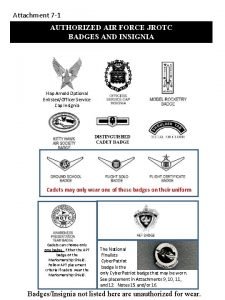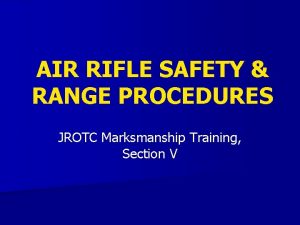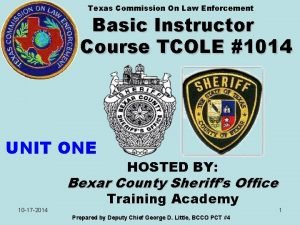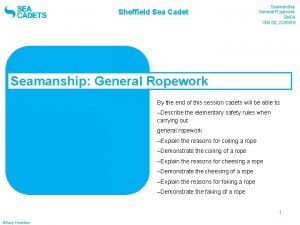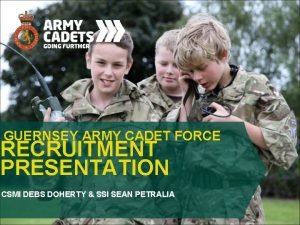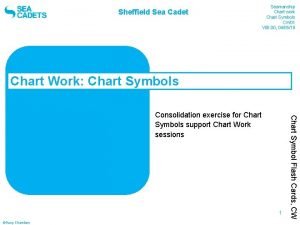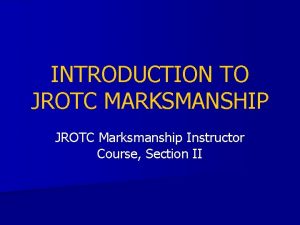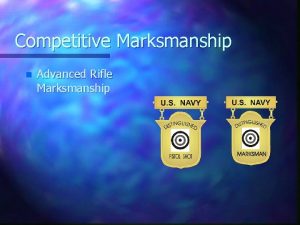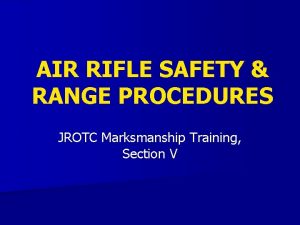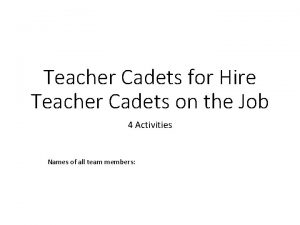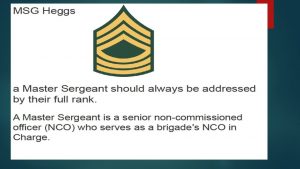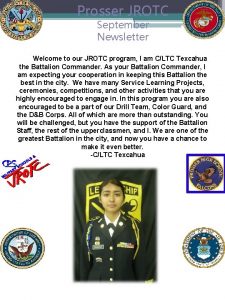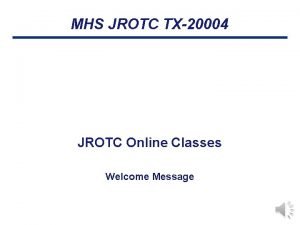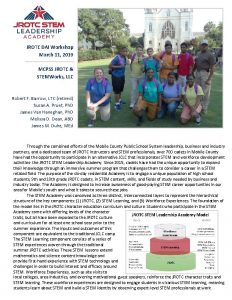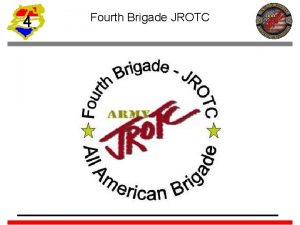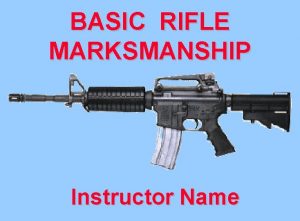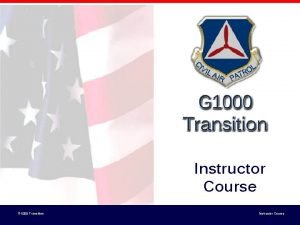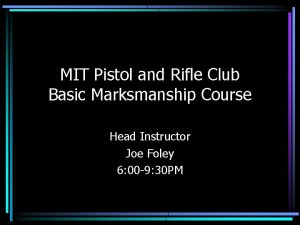TEACHING MARKSMANSHIP TO CADETS JROTC Marksmanship Instructor Course



















- Slides: 19

TEACHING MARKSMANSHIP TO CADETS JROTC Marksmanship Instructor Course, Section VI

Teaching Marksmanship to Cadets (Coaching New Shooters) Section Objective: To review the principles and guidelines for teaching basic marksmanship to JROTC cadets

Rifle Marksmanship Curricula JMIC Instructional Material for Cadets: Section II, Introduction to JROTC Marksmanship Section V, Air Rifle Safety Section VII, Learning Rifle Marksmanship Skills § § VII, A, Shot Technique and Familiarization Firing VII, B, Standing Position VII, C, Use of the Sling and Prone Position VII, D, Kneeling Position Section VIII, Marksmanship Opportunities and Challenges Section IX, Becoming a Better Shooter

Instructional Options I. Safety and Familiarization Firing Introduction to marksmanship Safety and range procedures Familiarization firing in supported position II. Basic Marksmanship Course (I + the following) Firing in standing position Use of the sling Firing in the prone (and kneeling) position(s) Qualification firing III. Rifle Team Activities (I + II + the following) Additional Instruction in three-position firing Practice firing on regular basis JROTC Postals/other competitions

Target Options Principle: Start with big targets--target must be large enough to contain all well aimed shots Misses are negative— hits are positive Recommend BMC Target Graduate to AR Target when shot groups fit scorings

Front Sight Inserts Target air rifle front sights use interchangeable inserts For new shooters-select the largest ring Advanced shooters--should be able to keep bull within ring while firing Post insert--not normally used (service rifle use)

Preparation for Shooting 1. 2. 3. 4. 5. 6. Check dominant eye--determine right or left handed firing Identify cross-dominant shooters (attach blinders) Fit stock lengths to shooters Give loading instructions Demonstrate supported position Teach basic shot technique Sight alignment Breath Control Sight picture Trigger control

Before You Start: Which Eye/Shoulder to Use? Answer: Shoot from the same shoulder as your dominant eye. Do an eye dominance test to determine which eye and shoulder you should use. Step 1: Use a card with a dime-sized hole. Hold it away from you and look at a distant object with both eyes open. Step 2: Bring the card back to your eyes while continuing to focus on the distant object. The hole will be drawn to your dominant eye. Shoot from that same shoulder.

For Cross-Dominant Shooters Cross-dominance: Aiming with nondominant eye Solution: Attach a 30 x 100 mm blinder to the rear sight

Air Rifle Stock Fit Correct Spacers can be removed or added to adjust stock length facilitates learning Have stocks of variable length available Match stock lengths to shooters—bent arm test is good indicator Have shooters use same rifle each day

Preparation: Loading Instruction Teach loading procedure before first live firing: 1. Open action 2. Charge air (pneumatic), pause when fully open 3. Place pellet on loading port--open end (skirt) to rear 4. Close action

Rifle Practice Drills or Exercises 1. 2. 3. 4. 5. 6. 7. Practice holding rifle in position while aiming at blank target Dry fire on a blank target Live fire 3 -5 shot groups on a blank target (objective: small shot groups) Holding/Dry fire on bull's-eye target Live fire 3 -5 shot groups on bull’seye target (objective: small shot groups) Adjust sights to center groups on target (Teach sight adjustment first) Shoot 5 or 10 shot series for score

Familiarization Firing Start in Supported Position Use to teach basics of firing the shot Fire from table or floor with support Support rifle with rest (kneeling roll, sandbag, etc. ) Allows new shooter to concentrate on shot technique

Correcting Serious Mistakes Failure to hit the target is unacceptable Serious New Shooter Errors Cross-dominant shooter--aims with other eye Solution: Attach blinder to rear sight Not looking through rear sight aperture Solution: Instruction/close observation Flinching/Jerking Trigger Solution: Demonstration/dry firing Shooting a rifle like a shotgun (point and shoot) Solution: Re-instruct on steps to fire shot, dry firing Be alert during first shot groups--if shooters do not hit targets, intervene immediately

Position Sequence Start new shooters in Supported position 1 st Regular Position: Standing Easiest, most natural position to learn Most important position to learn Successful if BMC target is used Charging M 853 easier in standing Requirement: Pellet holder (standing height) 2 nd Position: Prone 3 rd Position: Kneeling Introduce use of sling Standing and Prone scores required for Mks/SS qualification badges Most difficult position to teach All three positions required for Expert qualification badges

Teaching Firing Positions 1. Position Foundation 2. Elbow Location (left elbow for right handed shooters) Head & Butt-Plate Position Adjust Rifle Height (sights to target level) Tighten Sling (prone & kneeling) Orient position on target (natural point of aim) 3. 4. 5. 6. Standing--foot position Prone--body position on mat Kneeling--body position on kneeling roll

Teaching Sling Positions Start with sling on Start with sling long and loose Establish the position foundation Locate left elbow Position head & butt-plate Adjust rifle height Tighten sling Rotate position to target

Introducing a Firing Position Fundamental Principle: Teach only the minimum information necessary to build a sound position. The illustration shows the teaching points needed for standing. #3, butt-plate up in shoulder to keep head erect #4, adjust handwrist to raise sights to target #2, place elbow on side, under rifle #1, Turn the feet & body 90 degrees from the target

Positive Repetitions—Not Magic Shooting skills are developed through positive repetitions of correctly executed positions, shots and techniques Believe in practice—it is the real difference maker Give positive corrections, highlight the correct action, not the incorrect one
 Marksmanship instructor
Marksmanship instructor Jrotc marksmanship instructor course online
Jrotc marksmanship instructor course online Air force jrotc ranks
Air force jrotc ranks Air rifle backstop curtain
Air rifle backstop curtain Tcole advanced instructor course
Tcole advanced instructor course Basic instructor course texas
Basic instructor course texas Basic instructor course #1014
Basic instructor course #1014 Basic instructor course #1014
Basic instructor course #1014 Basic instructor course #1014
Basic instructor course #1014 Tcole 1014 basic instructor course
Tcole 1014 basic instructor course Tcole basic instructor course
Tcole basic instructor course Pepperball instructor course
Pepperball instructor course Tcole advanced instructor course
Tcole advanced instructor course Tcole instructor course
Tcole instructor course Basic instructor course texas
Basic instructor course texas Sheffield sea cadets
Sheffield sea cadets Acf values and standards powerpoint
Acf values and standards powerpoint Air cadets
Air cadets Air cadets badges
Air cadets badges Cadets
Cadets


